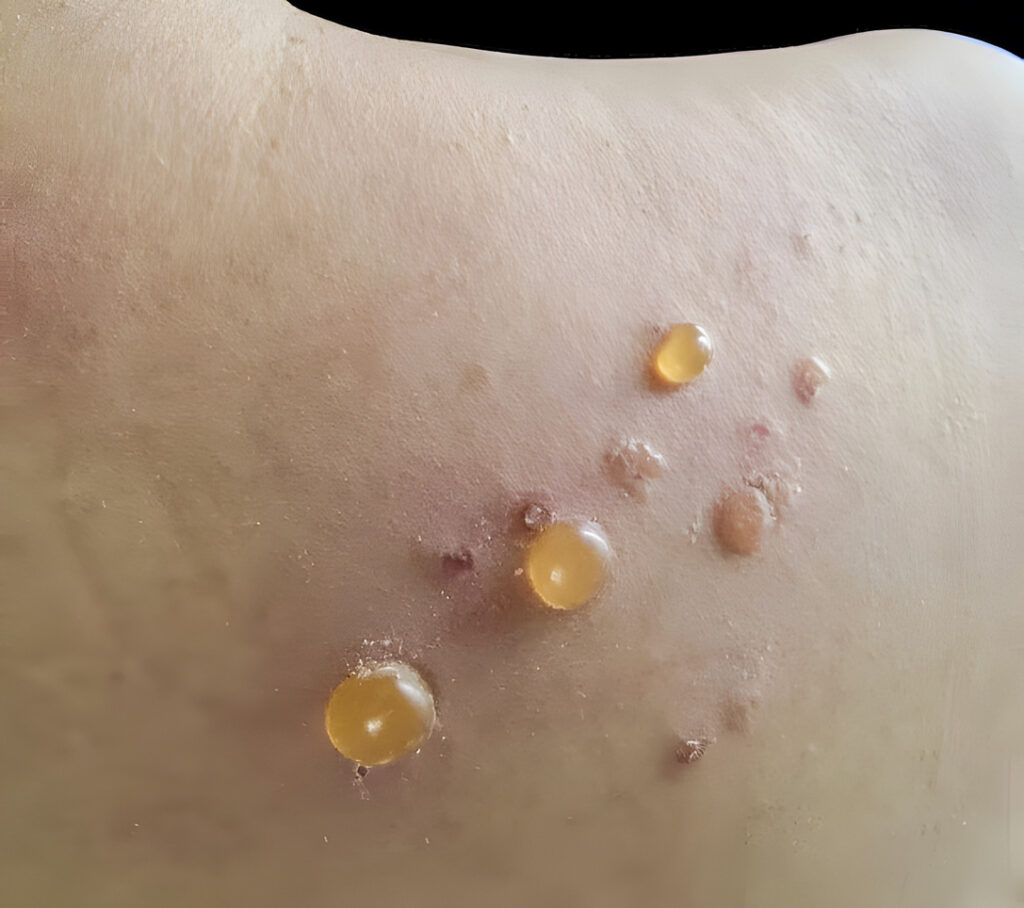Dupilumab (Dupixent, Sanofi and Regeneron) met the primary and all key secondary endpoints in a Phase 2/3 study of adults with moderate-to-severe disease bullous pemphigoid (BP), Sanofi reports.
In the study, five times more dupilumab patients achieved sustained disease remission compared to those on placebo. Sustained disease remission was defined as complete clinical remission with completion of oral corticosteroids (OCS) taper by week 16 without relapse and no rescue therapy use during the 36-week treatment period.
Dupilumab was previously granted Orphan Drug Designation by the U.S. Food and Drug Administration for BP. This study will support regulatory submissions around the world, starting with the U.S. later this year. If approved, dupilumab would be the first and only targeted medicine to treat BP in the U.S. and European Union
“There is a significant unmet medical need for new medicines for people suffering with this hard-to-treat disease in which the standard of care is oral and topical corticosteroids and immunosuppressants – treatments that have poor clinical outcomes and safety concerns, respectively, and should be used sparingly in an elderly population,” says Dietmar Berger, MD., PhD, Chief Medical Officer, Global Head of Development at Sanofi, in a news release. “These positive pivotal results for bullous pemphigoid add to an immense body of scientific evidence that underscores the important role IL4 and IL13 play in driving diseases characterized by itch. Combined with the consistent safety profile of the other dermatology indications, these results show the potential of Dupixent to transform the treatment paradigm for bullous pemphigoid.”
In the ADEPT study, 106 adults with moderate-to-severe BP were randomized to receive dupilumab 300 mg (n=53) every two weeks after an initial loading dose or placebo (n=53), along with standard-of-care OCS. During treatment, all patients underwent a protocol-defined OCS tapering regimen if control of disease activity was maintained.
For the primary endpoint, 20% of dupilumab patients experienced sustained disease remission at 36 weeks compared to 4% for placebo (p=0.0114). For the components comprising the primary endpoint – with patients having to achieve all components – efficacy among patients receiving dupilumab compared to placebo was as follows*:
- Absence of disease relapse after patient completed OCS taper: 59% vs. 16%
- Absence of need for rescue therapy during treatment period: 42% vs. 12%
- Achievement of complete remission and off OCS by week 16: 38% vs. 27% (not significant)
*Components were not separately included in pre-specified statistical analyses and are therefore nominal
For selected secondary endpoints, results for dupilumab compared to placebo were statistically significant as follows:
- Patients achieving ≥90% reduction in disease severity: 41% vs. 10%
- Patients achieving clinically meaningful itch reduction: 40% vs. 11%
- Secondary endpoints assessing decreased OCS use, and time to use of rescue medications, also favored dupilumab and were significant
- Reduction in disease severity from baseline: 77% vs. 51%
- Reduction in itch from baseline: 52% vs. 27%
- Days of complete remission off OCS: 40 vs. 13
In this older population, overall rates of adverse events (AEs) were 96% (n=51) for Dupilumab and 96% (n=51) for placebo. AEs more commonly observed with Dupilumab compared to placebo in more than 3 patients included peripheral edema (n=8 vs. n=5), arthralgia (n=5 vs. n=3), back pain (n=4 vs. n=2), blurred vision (n=4 vs. n=0), hypertension (n=4 vs. n=3), asthma (n=4 vs. n=1), conjunctivitis (n=4 vs. n=0), constipation (n=4 vs. n=1), upper respiratory tract infection (n=3 vs. n=1), limb injury (n=3 vs. n=2), and insomnia (n=3 vs. n=2). There were no AEs leading to death in the Dupilumab group and 2 AEs leading to death in the placebo group.
“These latest pivotal results reaffirm the underlying role type-2 inflammation plays in driving multiple skin diseases,” says George D. Yancopoulos, MD, PhD, Board co-Chair, President, and Chief Scientific Officer at Regeneron. “We look forward to further advancing this research and sharing the positive results from the bullous pemphigoid pivotal trial with regulatory authorities.”
More About the Dupixent BP pivotal study
ADEPT is a randomized, phase 2/3, double-blind, placebo-controlled study evaluating the efficacy and safety of dupilumab in 106 adults with moderate-to-severe BP for a 52-week treatment period. After randomization, patients received dupilumab or placebo every two weeks, with OCS treatment. During treatment, OCS taper was initiated after patients experienced two weeks of sustained control of disease activity. OCS tapering could start between four to six weeks after randomization and was continued as long as disease control was maintained, with the intent of completion by 16 weeks. After OCS tapering, patients were only treated with dupilumab or placebo for at least 20 weeks, unless rescue treatment was required.
The primary endpoint evaluated the proportion of patients achieving sustained disease remission at 36 weeks. Sustained disease remission was defined as complete clinical remission with completion of OCS taper by 16 weeks without relapse and no rescue therapy use during the 36-week treatment period. Relapse was defined as appearance of ≥3 new lesions a month or ≥1 large lesion (>10cm in diameter) that did not heal within a week. Rescue therapy could include treatment with high-potency topical corticosteroids, OCS (including increase of OCS dose during the taper or re-initiation of OCS after completion of the OCS taper), systemic non-steroidal immunosuppressive medications, or immunomodulating biologics.
Select secondary endpoints evaluated at 36 weeks included:
- Proportion of patients achieving ≥90% reduction in Bullous Pemphigoid Disease Area Index (BPDAI; scale:0-360)
- Proportion of patients with ≥4-point reduction in Peak Pruritus Numerical Rating Scale (PP-NRS; scale 0-10)
- Total cumulative OCS dose
- Time to first use of rescue medication
- Percent change from baseline in BPDAI
- Percent change in weekly average of daily PP-NRS
- Duration of complete remission while not requiring OCS


